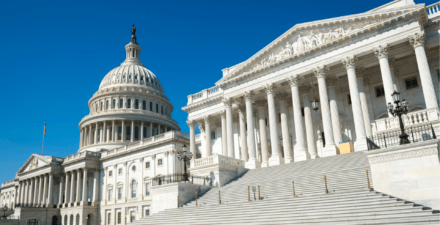The economic imperative of enacting paid family leave across the United States

This essay is part of Vision 2020: Evidence for a stronger economy, a compilation of 21 essays presenting innovative, evidence-based, and concrete ideas to shape the 2020 policy debate. The authors in the new book include preeminent economists, political scientists, and sociologists who use cutting-edge research methods to answer some of the thorniest economic questions facing policymakers today.
To read more about the Vision 2020 book and download the full collection of essays, click here.
Overview
Many workers across the United States have caregiving responsibilities. The majority of mothers and fathers of infants and small children work in the labor force, and the aging of the baby boomer population implies that many workers have parents and other older relatives who may require care. Paid family leave policies are designed to help employees balance the competing needs of work and family by allowing them to take time off from work with partial wage replacement to care for newborn or newly adopted children or ill family members.
Yet the United States remains one of only a few countries in the world without any national paid family leave policy and the only high-income country without one.1 Only 17 percent of U.S. private-sector workers have access to paid family leave through their employers, and this access is highly unequal—meaning that low-income workers have much less access than their higher-income counterparts.2 Federal law requires 12 weeks of job-protected unpaid leave under the 1993 Family and Medical Leave Act, but stringent eligibility requirements mean that less than two-thirds of the U.S. workforce is eligible. Not surprisingly, the majority of working parents report that their work-family balance is a significant challenge.3
Paid family leave is receiving significant attention in the political discourse. At the end of 2019, Congress and the Executive Branch reached agreement to extend six weeks of parental paid leave for a newly born or adopted child to the federal workforce. During the 2016 election, for the first time in U.S. history, both Democratic and Republican presidential candidates included paid leave proposals in their campaign platforms. Advocates credit paid family leave with encouraging career continuity and advancement for women and improving child and family health and well-being. There is also growing interest in encouraging men to take leave, in an effort to promote gender equality both at home and in the labor market. Yet some business groups and other opponents of paid family leave argue that it could impose substantial costs on employers. Paid time away from work could lower employees’ attachment to their jobs, and even lead to discrimination against women (who are more likely than men to take leave).
In this essay, we first examine paid family leave programs at the state and local level, which are helping to set the stage for a federal paid leave program. We then describe the current research on the impacts of paid family leave on workers, children, and employers, with an eye toward understanding the economic costs and benefits of a potential federal program and the key policy levers to consider. We also briefly discuss how paid family leave may relate to the growth in economic inequality in America and whether a federal policy could help curb this trend.
Paid family leave policies can cover both bonding with a new child and caring for other relatives, but in this essay, we will focus the discussion on the effects of bonding leave. This restriction stems from a lack of research on the impacts of nonbonding leave and the fact that bonding leaves currently make up the vast majority of all claims in states with paid family leave programs.4
Paid family leave at the state and local level
There has been substantial policy action for paid family leave at the state and local level. California became the first state to enact legislation in 2004, followed by New Jersey (in 2009), Rhode Island (in 2014), and New York (in 2018). Washington state and the District of Columbia both recently passed legislation, with benefits available starting in 2020. Massachusetts, Connecticut, and Oregon also recently passed laws to start providing paid family leave benefits in 2021, 2022, and 2023, respectively.5 At least 16 other states have introduced similar legislation.
The current state and local paid family leave laws are all similar in that they provide partial wage replacement during leave and cover a broad segment of the workforce through minimal eligibility requirements. But they differ on several key policy levers: duration, benefit amount, job protection, funding mechanism, and what constitutes a qualifying event.
Wage-replacement rates vary from 50 percent to 100 percent (up to a weekly maximum benefit amount) for 4–12 weeks. The maximum benefit amount currently ranges from $650 to $1,250 per week. While higher-income workers receive higher total benefit amounts, the replacement rate is higher for low-wage workers in California (as of 2018), the District of Columbia, Massachusetts, Washington state, Oregon, and Connecticut. Paid family leave legislation in California, New Jersey, and the District of Columbia do not have any provisions for job protection, which require that employers allow workers to return to their preleave jobs after the leave has ended, though eligible workers can simultaneously take job-protected unpaid leave under current federal or state law. The other states specifically include job security provisions for most employees in their paid family leave laws.
Most states fund paid family leave entirely through employee payroll taxes, while the District of Columbia has a payroll tax on employers. In Oregon and Washington state, the leave will be jointly financed between employees and employers. This payroll tax is currently between 0.1 percent and 1 percent of wages (up to a cap) across states.
All states cover leaves associated with the arrival of a new child (through birth, adoption, or foster care) and serious health conditions of close family members. But the definition of close family members varies somewhat across programs. Additionally, Massachusetts and Washington state will cover needs related to the military deployment of a family member. New Jersey and Oregon include specific provisions to cover victims of domestic violence and their caregivers.
Paid family leave and take-up by employees
Most Americans support a national paid family leave policy.6 But how many workers would such a policy benefit? Evidence from California indicates both mothers and fathers value it. The leave-taking rate of mothers with infants nearly doubled after paid family leave became available, while fathers were 50 percent more likely to take leave.7 This increase in leave-taking indicates that access causes new parents to take more time away from work following the birth of a new child than they would in the absence of the policy. But even those who do not change their leave-taking behavior may benefit by receiving partial wage replacement during periods of leave that would have otherwise been unpaid. Overall, a recent study by one of the co-authors of this essay, along with two other colleagues, estimates that about 47 percent of employed new mothers and 12 percent of employed new fathers in California made a paid family leave claim in 2014.8
Why don’t all new parents access this paid family leave program? There are a number of barriers that may limit take-up, including lack of policy awareness, too-low pay, or the absence of job protection.9 These barriers may be especially high for workers in low-wage jobs, who are less likely to be eligible for job protection through the current federal unpaid leave law and less likely to be able to afford to take even partially paid leave.10
Paid family leave and workers’ labor market trajectories
Paid family leave could impact workers’ subsequent labor market outcomes such as employment and wages in several different ways. Because paid leave increases the time parents spend away from work, it could lead to a loss of job-specific skills and make re-entry into the labor market more difficult. Yet the availability of paid family leave, particularly when job protection is available, may reduce the probability that new parents quit their jobs upon the birth of a child. This could have a positive effect on job continuity and future earnings.
Although employers are not responsible for paying employees during the leave, extended absences are costly in other ways. The productivity of firms, for example, may decrease if it is difficult to reassign tasks or hire a replacement while an employee is on leave for several weeks. Employers who find leaves particularly costly may discriminate against groups most likely to take up the leave—new mothers or women of childbearing age—by being less likely to hire them or offering them lower wages.
Studies on these programs in other countries typically find that provisions of leave up to 1 year in length increase the employment of mothers shortly after childbirth and have positive or zero effects on wages, though longer leave entitlements can have adverse effects on maternal long-term employment and wage trajectories.11 There is no evidence that paternity leave impacts fathers’ subsequent labor market outcomes.12
The evidence on the employment effects of paid family leave in the United States is mixed. While several studies have found the introduction of paid family leave in California had positive impacts on employment and wages of new mothers in the short term, recent work using large-scale administrative data finds zero or small negative impacts on long-term employment and wages.13
Moreover, it is possible that the design of the leave policy in terms of its specific components (such as duration, replacement rate, and the inclusion of job protection) matters. Yet there is limited research on this question because it is hard to isolate the effect of a particular policy lever from the other features that are implemented at the same time. That said, new research by one of the co-authors of this essay, along with two other colleagues, isolated the impact of the wage-replacement rate in California’s paid family leave program for relatively high-income mothers, finding that higher benefit amounts do not affect either the duration of leave or the probability of making a claim, but may improve job continuity by increasing the likelihood that women return to their preleave employers.14
Paid family leave and family health outcomes
A lot of the discussion about the importance of paid family leave focuses on women’s labor market trajectories, yet these policies may also be beneficial for families more broadly. For instance, paid leave could impact maternal and child health and well-being. Access to leave may lower maternal stress during pregnancy, which has been shown to adversely affect child well-being at birth and in later life.15 Paid family leave also may impact breastfeeding duration, enable parents to obtain prompt healthcare for their infants, improve maternal postpartum physical and mental health, and strengthen parent-child bonds.
While studies of the impacts of extensions in already-generous paid family leave policies on children from other countries find no effects, they offer little guidance on what one might expect from the introduction of a shorter-but-similar federal program such as those now being considered in the United States.16 There is one instructive example that comes from research on the long-term impacts of the 1977 implementation of a four-month paid maternity leave policy in Norway. That research shows that it led to a reduction in high school drop-out rates and an increase in adult earnings, concentrated among children from disadvantaged backgrounds.17 Another study further shows that the same policy improved a range of maternal health indicators, with the benefits again concentrated among women from less advantaged backgrounds.18
We can also draw on a small body of research conducted in the U.S. context. One study shows that the introduction of paid maternity leave in five U.S. states lowered rates of low birth-weight and preterm births, with the largest impacts among African American and unmarried mothers. Improvements in these measures of health at birth have been correlated with improvements in long-term health, suggesting that paid leave may have long-lasting benefits for kids. The introduction of paid family leave in California also is associated with increases in the duration of breastfeeding, reductions in hospitalizations for infants due to avoidable infections and illnesses, and improvements in maternal mental health.19
Although paid family leave policies at the state and local level in the United States have not existed long enough to study the long-term impacts of children’s health into adulthood, there is already some evidence of improvements in later childhood health. The introduction of California’s paid family leave program is associated with lower rates of being overweight, attention deficit hyperactivity disorder, and hearing problems in Kindergarten.20 Recent work finds that paid family leave also increases time mothers spend in childcare activities, suggesting that improvements in childhood health may be driven by both physiological and behavioral channels.21
Paid family leave and employers
A central concern among opponents of government-mandated paid family leave is the costs imposed on employers. Even if employers do not have to fund the leave, they could face indirect costs from the need to hire replacement workers, coordinate employee schedules, or reassign work tasks. Alternatively, employers could experience cost savings if workers who would have otherwise quit instead return to their jobs and reduce turnover rates.
The existing evidence on the impacts of paid family leave on employers is sparse. Surveys of selected firms in California and New Jersey find that the vast majority of employers report either positive or neutral effects on employee productivity, morale, and costs.22 These studies do not find much evidence that program administration has been challenging or that employees resent their co-workers who take leave.
Then, there’s the recent survey of small and medium-sized businesses in the food services and manufacturing sectors in Rhode Island, Connecticut, and Massachusetts just before and shortly after Rhode Island’s paid family leave program went into effect.23 Comparing Rhode Island employers pre- and post-law to Massachusetts and Connecticut employers over the same time period, the study found no evidence of significant impacts of the law on outcomes such as turnover rates or employee productivity. Still, the sample sizes were small, limiting the conclusions that could be drawn from this analysis.
One of the co-authors of this essay and another colleague used administrative data on nearly all California employers that ever existed between January 2000 and December 2014 to study how employers’ labor costs and productivity respond to changes in employee leave-taking rates.24 They find no evidence that employee turnover or wage costs change when leave-taking rates rise. In fact, the average firm has a lower per-worker wage bill and a lower turnover rate today than it did before California’s paid family leave program was introduced.
But there still may be significant differences in the costs of paid family leave faced by different firms. Again using administrative from California, another recent analysis finds that take-up of paid leave is substantially higher in firms that pay similarly skilled workers relatively higher wages.25 These firms also have higher employee retention following periods of leave. That research posits that better-paying firms may have cultures that are more conducive to leave-taking, suggesting that changing firm behavior and norms may be important for encouraging the use of leave more broadly.
Download FileThe economic imperative of enacting paid family leave across the United States
Conclusion
As other states and the nation as a whole consider paid family leave legislation, it is critically important to understand the costs and benefits of existing programs and identify key policy features. The current research yields five key take-aways.
First, both mothers and fathers respond to the introduction of paid family leave programs through higher leave-taking rates and longer leave duration, but barriers to take-up remain, especially among low-wage workers in small firms. Job protection and high wage-replacement rates for workers at the bottom of the wage distribution may be important for encouraging more widespread take-up.
Second, relatively short leave entitlements can improve job continuity for women and increase their employment rates several years after childbirth. Paid leaves longer than 1 year, however, could have adverse consequences for mothers’ long-term career opportunities.
Third, the current paid leave programs at the state and local level in the United States have positive impacts on child health and development, as well as maternal well-being. Thus, while there is no research identifying the “optimal” duration of leave precisely, it appears that programs of up to six months in length are likely to generate benefits for families without significant costs to women’s careers.
Fourth, the current evidence shows minimal negative impacts of existing state programs on employers, suggesting that paid family leave programs afford benefits to workers and their families at little to no cost to the employers. These benefits may be especially important for the least advantaged families, in which workers are the least likely to have access to any employer-provided paid leave.
Finally, a growing body of evidence underscores that rising economic inequality and persistent intergenerational transmission of low socioeconomic status in the United States are perpetuated through disparities in early childhood circumstances.26 The current research suggests that a federal paid family leave policy could level the playing field for children from all backgrounds and help curb the growth in inequality and boost long-term U.S. economic growth and stability.
—Maya Rossin-Slater is an assistant professor of health policy in the Department of Medicine at Stanford University School of Medicine. Jenna Stearns is an assistant professor of economics at the University of California, Davis.
End Notes
1. For information on paid family leave policies around the world, see: “Is paid leave available to mothers and fathers of infants?,” available at https://www.worldpolicycenter.org/policies/is-paid-leave-available-to-mothers-and-fathers-of-infants/is-paid-leave-available-for-mothers-of-infants (last accessed September 17, 2019).
2. “Employee Benefits Survey,” available at https://www.bls.gov/ncs/ebs/benefits/2018/ownership/civilian/table32a.htm (last accessed September 17, 2019).
3. See, for example, Pew Research Center, “Raising Kids and Running a Household: How Working Parents Share the Load” (2015), available at http://www.pewsocialtrends.org/2015/11/04/raising-kids-and-running-a-household-how-working-parents-share-the-load/.
4. For example, in California, bonding leaves currently make up about 87 percent of all claims. See California Employment Development Department, “Paid Family Leave (PFL) Program Statistics” (n.d), available at https://www.edd.ca.gov/about_edd/pdf/qspfl_PFL_Program_Statistics.pdf.
5. California, New Jersey, New York, and Rhode Island already offered temporary disability insurance programs that provide similar wage replacement during own illness or injury prior to passing paid family leave legislation. Washington state, the District of Columbia, Massachusetts, Connecticut, and Oregon have passed paid family and medical leave laws, which will cover both caring for family members and own illness/injury.
6. National Partnership for Women & Families, “Voters’ Views on Paid Family + Medical Leave: Findings from a National Survey” (2018), available at http://www.nationalpartnership.org/our-work/resources/workplace/paid-leave/voters-views-on-paid-family-medical-leave-survey-findings-august-2018.pdf.
7. Ann Bartel and others, “Paid Family Leave, Fathers’ Leave-Taking, and Leave-Sharing in Dual-Earner Households,” Journal of Policy Analysis and Management 37 (1) (2018): 10–37, available at https://doi.org/10.1002/pam.22030; Maya Rossin-Slater, Christopher J. Ruhm, and Jane Waldfogel, “The Effects of California’s Paid Family Leave Program on Mothers’ Leave-taking and Subsequent Labor Market Outcomes,” Journal of Policy Analysis and Management 32 (2) (2013): 224–245, available at https://doi.org/10.1002/pam.21676.
8. Sarah Bana, Kelly Bedard, and Maya Rossin-Slater, “Trends and Disparities in Leave Use under California’s Paid Family Leave Program: New Evidence from Administrative Data,” AEA Papers and Proceedings 108 (2018): 388–91, available at http://www.aeaweb.org/articles?id=10.1257/pandp.20181113.
9. See, for example Eileen Appelbaum and Ruth Milkman, “Leaves That Pay: Employer and Worker Experiences with Paid Family Leave in California.” Technical report (2011), available at https://escholarship.org/uc/item/6bm118ss; Ruth Milkman and Eileen Appelbaum, Unfinished Business: Paid Family Leave in California and the Future of U.S. Work-Family Policy (Ithaca, NY: ILR Press, 2013); Mark DiCamillo and Mervin Field, “Just 36% of voters aware of state’s paid family leave program.” Technical report (Field Research Corporation, 2015).
10. Sarah Fass, “Paid Leave in the States: A Critical Support for Low-wage Workers and Their Families.” Technical report (2009), available at https://academiccommons.columbia.edu/doi/10.7916/D8XH00VS.
11. See, for example: Christopher J. Ruhm, “The Economic Consequences of Parental Leave Mandates: Lessons from Europe,” Quarterly Journal of Economics 113 (1) (1998): 285–317, available at https://doi.org/10.1162/003355398555586; Michael Baker and Kevin Milligan, “Evidence from Maternity Leave Expansions of the Impact of Maternal Care on Early Child Development,” Journal of Human Resources 45 (1) (2010): 1–32, available at http://jhr.uwpress.org/content/45/1/1.short; Jochen Kluve and Marcus Tamm, “Parental Leave Regulations, Mothers’ Labor Force Attachment and Fathers’ Childcare Involvement: Evidence from a Natural Experiment,” Journal of Population Economics 26 (3) (2013): 983–1005, available at https://doi.org/10.1007/s00148-012-0404-1; Francine D. Blau and Lawrence M. Kahn, “Female Labor Supply: Why is the United States Falling Behind?,” The American Economic Review 103 (3) (2013): 251–256, available at https://www.aeaweb.org/articles?id=10.1257/aer.103.3.251; Gordon B. Dahl and others, “What is the Case for Paid Maternity Leave?,” Review of Economics and Statistics 98 (4) (2016): 655–670, available at https://doi.org/10.1162/REST_a_00602; Jenna Stearns, “The Long-Run Effects of Wage Replacement and Job Protection: Evidence from Two Maternity Leave Reforms in Great Britain.” Technical report (2018), available at https://dx.doi.org/10.2139/ssrn.3030808. For overviews of the paid family leave literature, see Maya Rossin-Slater, “Maternity and Family Leave Policy.” In Susan L. Averett, Laura M. Argys, and Saul D. Hoffman, eds., The Oxford Handbook on the Economics of Women (New York: Oxford University Press, 2018); Claudia Olivetti and Barbara Petrongolo, “The Economic Consequences of Family Policies: Lessons from a Century of Legislation in High-Income Countries,” The Journal of Economic Perspectives 31 (1) (2017): 205–230, available at https://www.aeaweb.org/articles?id=10.1257/jep.31.1.205.
12. Sara Cools, Jon H. Fiva, and Lars J. Kirkebøen, “Causal Effects of Paternity Leave on Children and Parents,” Scandinavian Journal of Economics 117 (3) (2015): 801–828, available at https://doi.org/10.1111/sjoe.12113; John Ekberg, Rickard Eriksson, and Guido Friebel, “Parental Leave—A Policy Evaluation of the Swedish ‘Daddy-month’ Reform,” Journal of Public Economics 97 (2013): 131–143, available at https://doi.org/10.1016/j.jpubeco.2012.09.001; Ankita Patnaik, “Reserving Time for Daddy: The Consequences of Fathers’ Quotas,” Journal of Labor Economics, forthcoming, available at https://doi.org/10.1086/703115.
13. Rossin-Slater, Ruhm, and Waldfogel, “The Effects of California’s Paid Family Leave Program on Mothers’ Leave-taking and Subsequent Labor Market Outcomes”; Charles L. Baum and Christopher J. Ruhm, “The Effects of Paid Family Leave in California on Labor Market Outcomes,” Journal of Policy Analysis and Management 35 (2) (2016): 333–356, available at https://doi.org/10.1002/pam.21894; Sarah Bana, Kelly Bedard, and Maya Rossin-Slater, “The Impacts of Paid Family Leave Benefits: Regression Kink Evidence from Administrative Data” (Stanford, CA: Stanford University, 2018), available at https://www.nber.org/papers/w24438; Martha Bailey and others, “The Long-term Effects of California’s 2004 Paid Family Leave Act on Women’s Careers: Evidence from U.S. Tax Data” (University of Michigan, 2019).
14. Bana, Bedard, and Rossin-Slater, “The Impacts of Paid Family Leave Benefits: Regression Kink Evidence from Administrative Data.”
15. Janet Currie and Maya Rossin-Slater, “Weathering the Storm: Hurricanes and Birth Outcomes,” Journal of Health Economics 32 (3) (2013): 487–503, available at https://doi.org/10.1016/j.jhealeco.2013.01.004; Sandra E. Black, Paul J. Devereux, and Kjell G. Salvanes, “Does Grief Transfer Across Generations? Bereavements during Pregnancy and Child Outcomes,” American Economic Journal: Applied Economics 8 (1) (2016): 193–223, available at https://www.aeaweb.org/articles?id=10.1257/app.20140262; Anna Aizer, Laura Stroud, and Stephen Buka, “Maternal Stress and Child Well-being: Evidence from Siblings,” Journal of Human Resources 51 (3) (2016): 523–555, available at https://www.ncbi.nlm.nih.gov/pmc/articles/PMC5673140/; Petra Persson and Maya Rossin-Slater, “Family Ruptures, Stress, and the Mental Health of the Next Generation,” American Economic Review 108 (4-5) (2018): 1214–1252, available at https://www.aeaweb.org/articles?id=10.1257/aer.20141406.
16. Baker and Milligan, “Evidence from Maternity Leave Expansions of the Impact of Maternal Care on Early Child Development”; Michael Baker and Kevin Milligan, “Maternity Leave and Children’s Cognitive and Behavioral Development,” Journal of Population Economics 28 (2) (2015): 373–391, available at https://doi.org/10.1007/s00148-014-0529-5; Qian Liu and Oskar Skans, “The Duration of Paid Parental Leave and Children’s Scholastic Performance Children’s Scholastic Performance,” The B.E. Journal of Economic Analysis & Policy 10 (1) (2010): 1–33, available at https://doi.org/10.2202/1935-1682.2329; Dahl and others, “What is the Case for Paid Maternity Leave?”
17. Pedro Carneiro, Katrine Løken, and Kjell Salvanes, “A Flying Start: Maternity Leave Benefits and Long Run Outcomes of Children,” Journal of Political Economy 123 (2) (2015): 365–412, available at https://doi.org/10.1086/679627.
18. Aline Butikofer, Julie Riise, and Meghan Skira, “The Impact of Paid Maternity Leave on Maternal Health.” Discussion Paper No. 04/2018 (NHH Dept. of Economics, 2018), available at https://ssrn.com/abstract=3139823.
19. For evidence on birth outcomes, see Jenna Stearns, “The Effects of Paid Maternity Leave: Evidence from Temporary Disability Insurance,” Journal of Health Economics 43 (2015): 85–102, available at https://doi.org/10.1016/j.jhealeco.2015.04.005. For evidence on breastfeeding, see Rui Huang and Muzhe Yang, “Paid Maternity Leave and Breastfeeding Practice Before and After California’s Implementation of the Nation’s First Paid Family Leave Program,” Economics & Human Biology 16 (2015): 45–59, available at https://doi.org/10.1016/j.ehb.2013.12.009. For evidence on infant and maternal health, see Ariel Marek Pihl and Gaetano Basso, “Did California Paid Family Leave Impact Infant Health?” Journal of Policy Analysis and Management 38 (1) (2019): 155–180, available at https://doi.org/10.1002/pam.22101; Lindsey Bullinger, “The Effect of Paid Family Leave on Infant and Parental Health in the United States,” Journal of Health Economics 66 (2019): 101–116, available at https://doi.org/10.1016/j.jhealeco.2019.05.006.
20. Shirlee Lichtman-Sadot and Neryvia Pillay Bell, “Child Health in Elementary School Following California’s Paid Family Leave Program,” Journal of Policy Analysis and Management 36 (4) (2017): 790–827, available at https://doi.org/10.1002/pam.22012.
21. Samantha Trajkovski, “California Paid Family Leave and Parental Time Use” (Syracuse, NY: Syracuse University, 2019), available at https://docs.wixstatic.com/ugd/c6de6e_7fcc7bf2b2ff47eca9fe9c7a9659ff34.pdf.
22. Appelbaum and Milkman, “Leaves That Pay: Employer and Worker Experiences with Paid Family Leave in California”; Miriam Ramirez, “The Impact of Paid Family Leave on New Jersey Businesses” (Bloustein School of Planning and Public Policy, 2012), available at https://bloustein.rutgers.edu/wp-content/uploads/2012/03/Ramirez.pdf; Sharon Lerner and Eileen Appelbaum, “Business As Usual: New Jersey Employers’ Experiences with Family Leave Insurance” (Washington: Center for Economic and Policy Research, 2014), available at https://ideas.repec.org/p/epo/papers/2014-12.html.
23. Ann Bartel and others, “Assessing Rhode Island’s Temporary Caregiver Insurance Act: Insights form a Survey of Employers” (Washington: U.S. Department of Labor Chief Evaluation Office, 2016), available at https://digitalcommons.ilr.cornell.edu/key_workplace/1597/.
24. Kelly Bedard and Maya Rossin-Slater, “The Economic and Social Impacts of Paid Family Leave in California: Report for the California Employment Development Department.” Technical Report (2016), available at https://www.dol.gov/wb/media/CA_Final_Report_2015_Final_Report.pdf.
25. Bana, Bedard, and Rossin-Slater, “The Impacts of Paid Family Leave Benefits: Regression Kink Evidence from Administrative Data.”
26. Anna Aizer and Janet Currie, “The Intergenerational Transmission of Inequality: Maternal Disadvantage and Health at Birth,” Science 344 (6186) (2014): 856–861, available at https://science.sciencemag.org/content/344/6186/856; Janet Currie, “Inequality at Birth: Some Causes and Consequences,” The American Economic Review 101 (3) (2011): 1–22, available at https://www.aeaweb.org/articles?id=10.1257/aer.101.3.1; Raj Chetty and others, “Where is the Land of Opportunity? The Geography of Intergenerational Mobility in the United States,” The Quarterly Journal of Economics 129 (4) (2014): 1553–1623, available at https://doi.org/10.1093/qje/qju022; Gary Solon, “Intergenerational Mobility in the Labor Market.” In Orley Ashenfelter and David Card, eds., Handbook of Labor Economics (Amsterdam: Elsevier, 1999), pp.1761–1800, available at https://doi.org/10.1016/S1573-4463(99)03010-2.






